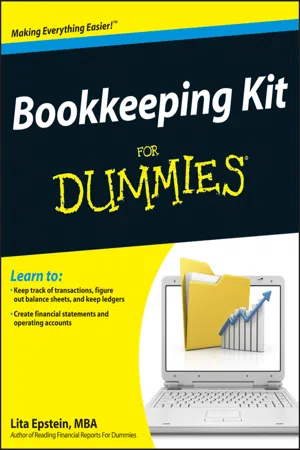Part I
Basic Bookkeeping: Why You Need It
In this part . . .
Not sure why bookkeeping is important? In this part, I explain the basics of how bookkeeping works and help you get started with the task of setting up your books.
This part also exposes you to terms that you may already know but that have a unique meaning in the world of bookkeeping, such as ledger, journal, posting, debit, and credit. Finally, I start you on your bookkeeping journey by showing you how to set up the road map for your books, the Chart of Accounts.
Chapter 1
So You Want to Do the Books
In This Chapter
Introducing bookkeeping and its basic purpose
Maintaining a paper trail
Managing daily business finances
Making sure everything’s accurate
Putting on a financial show
Few small business owners actually hire accountants to work full time. For a small business, that expense is probably too great, so the owner instead hires a bookkeeper who serves as the company accountant’s eyes and ears. In return, the accountant helps the bookkeeper develop good bookkeeping practices and reviews his or her work periodically (usually monthly).
In this chapter, I provide an overview of a bookkeeper’s work. If you’re just starting a business, you may be your own bookkeeper for a while until you can afford to hire one, so think of this chapter as your to-do list.
Delving Into Bookkeeping Basics
Like most businesspeople, you probably have great ideas for running your own business and just want to get started. You don’t want to sweat the small stuff, such as keeping detailed records of every penny spent; you just want to quickly build a business in which you can make lots of money.
Well, slow down there — this isn’t a race! If you don’t carefully plan your bookkeeping operation and figure out exactly how and what financial detail you want to track, you’ll have absolutely no way to measure the success (or failure, unfortunately) of your business efforts.
Bookkeeping, when done properly, gives you an excellent gauge of how well you’re doing. It also provides you with lots of information throughout the year so you can test the financial success of your business strategies and make course corrections early in the year if necessary to ensure that you reach your year-end profit goals.
Bookkeeping can become your best friend for managing your financial assets and testing your business strategies, so don’t shortchange it. Take the time to develop your bookkeeping system with your accountant before you even open your business’s doors and make your first sale.
Picking your accounting method
You can’t keep books unless you know how you want to go about doing so. The two basic accounting methods you have to choose from are cash-basis accounting and accrual accounting. The key difference between these two accounting methods is the point at which you record sales and purchases in your books. If you choose cash-basis accounting, you record transactions when cash changes hands only. If you use accrual accounting, you record a transaction when it’s completed, even if cash doesn’t change hands. I talk about the pros and cons of each type of accounting method in Chapter 2.
Understanding assets, liabilities, and equity
Every business has three key financial parts it must keep in balance: assets, liabilities, and equity. Assets include everything the company owns, such as cash, inventory, buildings, equipment, and vehicles. Liabilities include everything the company owes to others, such as vendor bills, credit card balances, and bank loans. Equity includes the claims owners have on the assets based on their portion of ownership in the company.
The formula for keeping your books in balance involves these three elements:
Assets = Liabilities + Equity
Because it’s so important, I talk a lot about how to keep your books in balance throughout this book. You can find an initial introduction to this concept in Chapter 2.
Introducing debits and credits
To keep the books, you need to revise your thinking about two common financial terms: debits and credits. Most nonbookkeepers and nonaccountants think of debits as subtractions from their bank accounts. The opposite is true with credits — people usually see these as additions to their accounts, in most cases in the form of refunds or corrections in favor of the account holders.
Well, forget all you thought you knew about debits and credits. Debits and credits are totally different animals in the world of bookkeeping. Because keeping the books involves a method called double-entry bookkeeping, you have to make a least two entries — a debit and a credit — into your bookkeeping system for every transaction. Whether that debit or credit adds or subtracts from an account depends solely upon the type of account.
I know all this debit, credit, and double-entry stuff sounds confusing, but I promise it becomes much clearer as you work through this book. I start explaining this critical yet somewhat confusing concept in Chapter 2. I also give you a chance to practice getting the numbers in the correct columns with practice exercises and answers in many chapters.
Charting your bookkeeping course
You can’t just enter transactions in the books willy-nilly. You need to know where exactly those transactions fit into the larger bookkeeping system. That’s where your Chart of Accounts comes in; it’...








